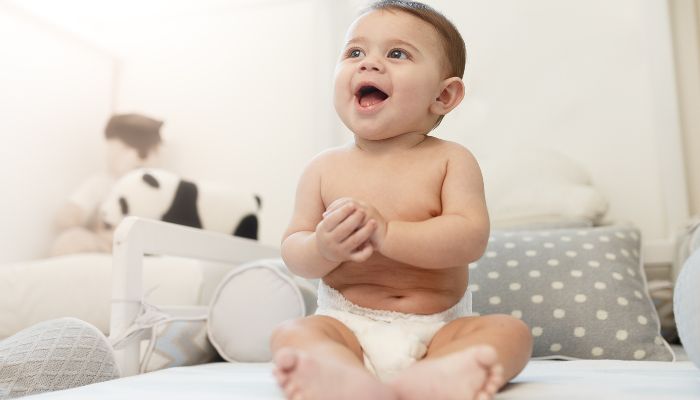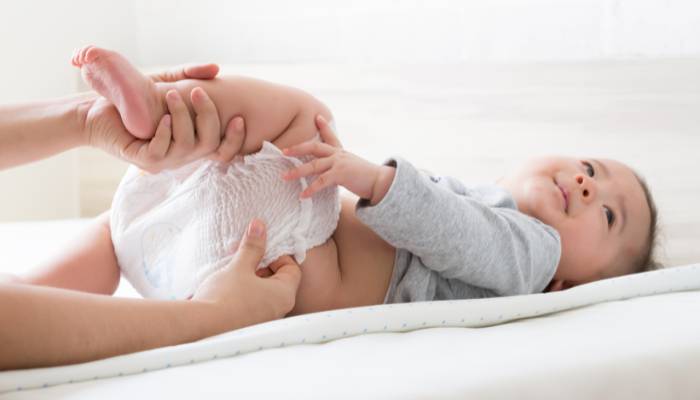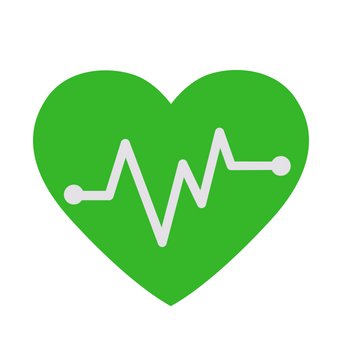Newborns are constantly wearing diapers which makes them prone to getting a diaper rash. And once those nasty rashes appear, babies get cranky due to pain and being uncomfortable. This makes it important for you to know the right treatment for bad diaper rash.

If you are looking for an effective way to get rid of diaper rash naturally, the list below has all the details you need to know.
What Is Diaper Rash?
Diaper rash, or diaper dermatitis [1], shows up as red, irritated patches on a baby’s bottom or sensitive areas. It can make babies fussy, leading to sleepless nights for parents.
The good news? Diaper rash isn’t serious and can be treated with proper care, like frequent diaper changes and the right remedies.
Rashes can range from mild to severe and happen for various reasons. Here are some common causes:
- Using tight diapers
- Fewer diaper changes
- Baby has diarrhea
- Baby has sensitive skin
- Baby has yeast or bacterial infection
7 Best Natural Remedies for Diaper Rash
Natural remedies for diaper rash soothe and heal without harsh chemicals. However, for moderate rashes, popular creams like Drapolene, can safely complement natural remedies.
Apple Cider Vinegar
Applying apple cider vinegar mixed with water can help relieve diaper rash. Wet bottom due to an unchanged diaper causes the baby’s skin to be alkaline.
A combination of apple cider vinegar and water can help neutralize the baby’s bottom when applied to the baby’s skin for 10 minutes. Allow this to air dry, then apply a natural moisturizer.
Aloe Vera Gel
Aloe vera is an antibacterial and antioxidant that can help relieve a baby’s irritated skin. Dab a small amount of aloe vera gel over the diaper rash to help speed up the healing process.
Baking Soda
Baking soda can also be used to treat diaper rash. Once applied to the baby’s bottom, it can balance the pH level of your baby’s skin. It also helps eliminate germs and fungi that can make the rashes worse.
Combine baking soda (2 tsp) with lukewarm water. Massage the mixture to your baby’s bottom using a soft and clean cloth.
Breastmilk
Breastmilk is indeed liquid gold. Not only is breastmilk the best food for your baby, but it can also help relieve irritated skin caused by diaper rash. Apply a few drops of breastmilk to the affected skin area. Let this air dry.
Coconut Oil
Coconut oil is a natural ingredient that has antifungal, anti-inflammatory, and antibacterial properties. Coconut oil is considered by many as an effective treatment for diaper rash in children. It is also a natural moisturizer for your baby’s skin.
In using coconut oil, you must first wash your baby’s bottom with warm water and pat dry with a soft and clean cloth. Once dry, apply ½ tbsp of coconut oil to the irritated areas.
Oatmeal Bath
Colloidal oatmeal can help reduce the irritation and inflammation caused by diaper rash, atopic dermatitis, and other skin inflammatory problems. Oatmeal bath treatments are available in most pharmacies and online stores.
Carefully read and follow the packaging instructions before use. You can pat dry the oatmeal bath treatment on your baby’s irritated skin.
Yogurt
Plain yogurt can also help treat and relieve a baby’s diaper rash. Apply a thick coat of room-temperature yogurt to the affected areas. You can expect improved results and a less-cranky baby in a couple of days.

4 Ways Your Baby Can Avoid Diaper Rash
It is possible for your baby to go through the first 12 months without experiencing diaper rash. Here are four ways your baby can avoid having it.
Change Diapers Regularly
As soon as your baby’s diaper is full, moist, or dirty, change it right away. If your child is highly sensitive to developing a diaper rash, you must change it even if it is mildly damp. A rash can be triggered even by little moisture build-up.
Gentle Washing of Baby’s Sensitive Area
It is essential to keep the baby’s diaper area clean and dry as much as possible. When washing the baby’s bottom, use a soft and clean cloth, water, and baby soap. Gently wash the baby’s bottom and avoid scrubbing it hard. Pat dry the bottom area.
Alternatively, if washing with water and soap is not possible, you may use fragrance-free, and alcohol-free baby wipes to clean the baby’s bottom. Better if you could use baby wipes that are best for sensitive skin.
Let Baby’s Skin Dry Out Thoroughly
When a baby has a diaper rash, they are so uncomfortable that they will not like wearing diapers. When the baby is not napping or sleeping, you can allow the baby to be diaper-free to keep the bottom dry for a longer time.
The rash heals faster when the skin is dry for a long time. You can let your baby do tummy time while placing disposable waterproof pads underneath them while diaper-free.
Use Disposable Diapers
Many parents are using cloth diapers because of the huge savings and convenience of using them compared to disposable diapers. However, a cloth diaper may not be ideal when your baby has a diaper rash.
Diaper rash can heal faster if you use a highly absorbent disposable diaper. It is also better to let your baby stay diaper-free as much as possible.
When Should You Bring Your Child to The Doctor?
Diaper rash can be cured easily at home with the proper treatment. However, if you notice that your baby’s rash is not healing despite treatment, is getting worse, or is recurring, it is better to schedule an appointment with your child’s physician as soon as possible.
Final Thoughts
A diaper rash can easily be treated at home. Several home remedies are made from natural ingredients that you can use to treat your child’s diaper rash.
You can try some of the natural remedies above before buying pharmacy-bought creams.
If the baby’s rashes worsen or they develop a fever, it is best to consult a physician immediately.

Lifebing is driven by an unrelenting passion for promoting health and well-being, our team is wholly committed to curating exceptional content and immersive experiences.
